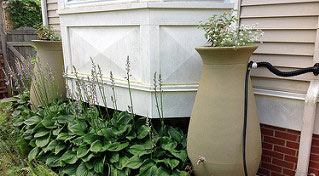Sprinkler System Maintenance
Update Your Sprinkler System’s Controller
Billions of gallons of water are wasted every day from inefficient landscape watering. Newer, more efficient irrigation-control technologies use local weather and landscape conditions to tailor watering schedules to the conditions in your yard. For example, a rain and freeze sensor automatically shuts off your irrigation system during rain or freezing temperatures. This landscape irrigation guide has additional information on watering efficiently.
Want more landscaping ideas? Click here for more great information about environmentally friendly yard care.
Setting Your Irrigation System for Optimum Efficiency
Water .75 to 1.0 inches every time you water, watering until soil is moist at least 4? deep in flowerbeds and deeper below turf. (One hour or more after watering, dig down with a screwdriver or other tool to check.) This will take several watering cycles with 45 minutes to an hour between each cycle to avoid losing water to runoff.
To set your timer:
- In each zone, run your sprinkler system until you begin to see runoff, then immediately turn off the water. This will tell you how long a cycle you can run in that zone without wasting water.
- Place tuna or cake pans between sprinklers for a period of time in each zone to learn how long it will take to get one inch of water. Be sure to run in cycles to avoid runoff!
- Water a total of .75 to 1.0? water once per week in short cycles are needed in that zone. Leave 45 minutes to an hour between cycles to give time for water to be absorbed.
- Extend time between watering as long as possible to allow time for roots to stretch deeper for moisture.
Signs of moisture stress:
Plants wilted in the morning; turf turning off color with dull purplish cast, leaf rolling or slight browning off, footprint tracks left when walked on. If you see these symptoms in just a few spots, water those few spots with a hose. As other parts dry down, then water the zone.
When more frequent watering might be needed:
If you have shallow soil, you may have to water more often in turf areas until you are able to build soil depth by using top dressing spring and fall.
In mid-summer extreme heat, there may be such high evapo-transpiration that you must water twice a week depending on your choice of plants and how successful you have been watering infrequently to develop deeper roots on your turf.
Notes: Shrubs and trees should be deeply soaked every three to four weeks during the dry season.
Trees: with pencil-sized stream, water area midway truck to drip-line and a little beyond. Divide into areas like face of clock, two hours or more each area. Keep moving around. Check moisture depth.
Check your watering system monthly. Be sure someone has access for your watering system when you are away from an extended time to adjust as necessary.
Need Help?
For assistance in programming your irrigation controller, call Customer Care at (512) 930-3640, or email customercare@georgetown.org.
Rain Barrels
Install and Maintain Rain Barrels
Now is a great time to install or perform routine maintenance on rain barrels. Rain barrels help conserve water by harvesting rain, which can be used instead of municipal or well water. Also, rainwater is better for your plants because it is free of salts and other minerals that harm root growth.
Check out this Texas A&M AgriLife video on how to make and install a rain barrel! Proper maintenance will help keep your rain barrels free of leaks, clogs, and mosquitoes.
Mulch
Use Mulch to Save Water
Mulch is a chemical-free, protective ground covering, which saves water and money by conserving the soil’s moisture. It also inhibits weed growth, prevents erosion, and moderates soil temperature.
City of Georgetown curbside-collected yard trimmings are brought to the City’s Collection Station where it is ground into mulch which is free to all Georgetown Utility customers living inside the city limits. Limit one free cubic yard of mulch per account, per month.
Currently while supply lasts, we are offering this great mulch to outside city limit customers who have Texas Disposal Systems (TDS) garbage service. Customers must have TDS garbage service in order to receive one yard of mulch free.
Applying Mulch
Water the ground thoroughly before and after applying mulch. Put a layer of mulch around trees and shrubs, but avoid piling it against the trunks and stems as this will cause disease and pest infestation. After settling, the mulch layer should be 4 inches deep around trees and 2 inches deep around shrubs. Check out this helpful Texas History guide, Mulching and Composting, for more information.










